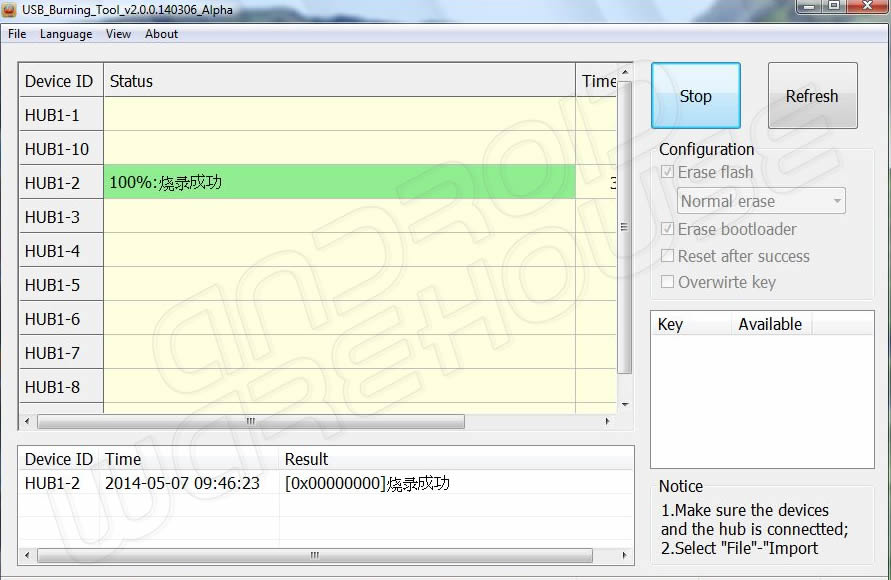- Usb Burning Tool Mac Address
- Usb Burning Tool Mac Ether.ini
- Usb_burning_tool_v2.0.6.2_build2
- Usb Burning Tool Download Mac
- Amlogic Usb Burning Tool
Hi all, I have been using USB burning tool v2.0.6.2 to update my OTT MXQ Pro 4K box a couple of times but recently I have been getting these errors below. To have the Microsoft tool create your bootable flash drive, make sure your flash drive is plugged in, select USB flash drive, and click Next. To use Rufus, select ISO file and click Next. This will save the.iso file to your computer; then, to use Rufus and your.iso file to create a bootable installation flash drive, follow the directions.
what's the best way to get an ISO 'burned' to a USB stick on a Mac? Restoring using Disk Utility does not work.
The ISO is ubuntu mini.iso. It is the minimalist install ISO for installing ubuntu. It needs to be bootable on a PC. I am trying to install ubuntu on a PC that has no CD-ROM. The only other computer I have around is a macbook.
Tamara WijsmanUsb Burning Tool Mac Address
8 Answers
Directly from the How to install Ubuntu on MacBook using USB Stick page(my formatting):
- Download the desired file
- Open the Terminal (in /Applications/Utilities/ or query Terminal in Spotlight)
- Convert the .iso file to .img using the convert option of hdiutil (e.g.,
hdiutil convert -format UDRW -o ~/path/to/target.img ~/path/to/ubuntu.iso) - Note: OS X tends to put the .dmg ending on the output file automatically. Remove the .dmg extension as necessary,
mv ~/path/to/target.img{.dmg,} - Run
diskutil listto get the current list of devices - Insert your flash media
- Run
diskutil listagain and determine the device node assigned to your flash media (e.g./dev/disk2) - Run
diskutil unmountDisk /dev/diskN(replaceNwith the disk number from the last command; in the previous example,Nwould be 2) - Execute
sudo dd if=/path/to/downloaded.img of=/dev/rdiskN bs=1m(replace/path/to/downloaded.imgwith the path where the image file is located; for example,./ubuntu.imgor./ubuntu.dmg). - Using
/dev/rdiskinstead of/dev/diskmay be faster.- If you see the error
dd: Invalid number '1m', you are using GNUdd. Use the same command but replacebs=1mwithbs=1M. - If you see the error
dd: /dev/diskN: Resource busy, make sure the disk is not in use. Start Disk Utility.app and unmount (don't eject) the drive.
- If you see the error
- Run
diskutil eject /dev/diskNand remove your flash media when the command completes - Restart your Mac and hold down Alt while the Mac is restarting to choose the USB stick
Note: On newer Macs you might have to install an EFI boot manager to boot from USB.
See also: Download Ubuntu Desktop.
ScottI had a very similar problem that none of these answered.
It's worth checking out UNetbootin. It will create a bootable USB disk on a Mac for a PC.
slhckThere is no need to convert the ISO to an IMG. I wasn't willing to convert an image first. This has easier steps, outlined below.
Start by listing the current disks and volumes:
Now unmount the current volume for the disk you are about to overwrite. (X = Drive number, in my case was 1):
Now dd the iso directly to the usb (again replace X with drive number of your USB drive):
Usb Burning Tool Mac Ether.ini
Done!
This is a very old question but still benefits from updated answers.
Etcher is now the solution recommended by Ubuntu to burn iso images to a USB drive.
Etcher makes the process almost painless if you are not comfortable with the command line. It's only 3 steps and worked on the first try for me.
- Ensure the USB Key is properly formatted (Master Boot Record, FAT32 - if necessary NTFS using NTFS-3G)
- You can try using the Restore feature in Disk Utility by clicking on the USB key's volume, then clicking on the Restore tab and choosing the ISO to restore onto it.
- If step 2 fails, you can do this manually by running
dittoorcp -r; eg.ditto /Volumes/NAME_OF_MOUNTED_ISO /Volumes/NAME_OF_USB_KEYorcp -r /Volumes/NAME_OF_MOUNTED_ISO /Volumes/NAME_OF_USB_KEYto manually copy all the files (including hidden ones)
 Chealion
ChealionUsb_burning_tool_v2.0.6.2_build2
Usb Burning Tool Download Mac
The way to do this using DiskUtility is to first format the drive using Diskutility and then copy over the files from the mounted iso to the newly formated drive using cp -R. Ex: cp -R /Volumes/mounted_iso/* /Volumes/formated_drive/
When formatting be sure to pick the ntfs file system and make the disk bootable by picking the correct option from the Options menu in the erase tab.
Amlogic Usb Burning Tool
Unetbootin is a tool that installs ISOs on USB keys, or you can use dropdown menus to select distributions right there in the tool.
Slightly easier than doing dd on the command line yourself.
I've user SuperDuper for this task before. It does the job and not much else. Like a good program should :-) The full version is not free ($30) but you get what you need for free:
You can download SuperDuper! v2.6.2 right now and back up and clone your drives for free— forever!